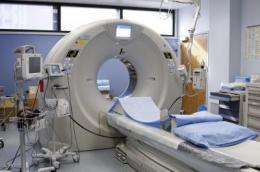Screening with low-dose spiral CT scanning reduces lung cancer deaths by 20 percent

Current or heavy smokers who were screened with low-dose spiral computed tomography (CT) scanning had a 20 percent reduction in deaths from lung cancer than did those who were screened by chest X-ray, according to results from a decade-long, large clinical trial that involved more than 53,000 people.
The study, called the National Lung Screening Trial (NLST), was conducted in individuals at high risk of developing lung cancer to compare the differences in death rates between smokers aged 55 to 74 who were screened annually with low-dose helical (or spiral) CT, versus the conventional chest X-ray.
The study results were published June 29, 2011 in the early online edition of the peer-reviewed New England Journal of Medicine.
Dr. Denise R. Aberle, national principal investigator for 23 of the 33 NLST sites and a researcher with UCLA's Jonsson Comprehensive Cancer Center, said this publication provides a more extensive analysis of the data than was initially reported in November 2010, and offers further definitive evidence of a significant mortality benefit from CT screening.
"These findings confirm that low dose CT screening can decrease deaths from lung cancer, which is expected to kill more than 150,000 Americans this year alone," said Aberle, who serves as vice chair for research in the Department of Radiological Sciences. "This study also will provide us with a road map for public policy development in terms of lung cancer screening in the years to come."
Beginning in August 2002, the NLST enrolled 53,454 men and women, including 1,578 individuals through the Jonsson Comprehensive Cancer Center. Participants had either a current or former cigarette smoking history of at least 30 pack-years, and had to be without symptoms or a history of lung cancer. Pack-years are calculated by multiplying the average number of packs of cigarettes smoked per day by the number of years a person has smoked.
Participants were randomly assigned to receive three annual screenings with either the low-dose spiral CT or the standard chest X-ray. Spiral CT uses X-rays to obtain multiple "slices" through the entire chest cavity during a seven- to 15-second breath-hold. A standard chest X-ray requires only a sub-second breath-hold, but produces just a single image of the whole chest in which anatomic structures overlie one another, perhaps obscuring a potential malignancy.
Previous studies to determine whether standard chest X-ray examinations can reduce lung cancer mortality have not been successful, primarily because of the small numbers of participants enrolled. The NLST is the first trial with sufficient numbers of participants using a randomized design to enable the comparison of mortality differences between spiral CT and chest X-ray, Aberle said.
Sponsored by the National Cancer Institute, part of the National Institutes of Health, the NLST establishes low-dose spiral CT as the first validated screening test that reduces lung cancer mortality. Aberle said that while the results are very encouraging and should re-shape screening guidelines in the future, CT screening is not an alternative to smoking cessation. The best and most effective way to reduce lung cancer deaths is for smokers to quit and for those who don't smoke to refrain from starting.
One of the major limitations of CT screening is the number of screens in which a nodule or other indeterminate finding potentially related to lung cancer is found.
"These abnormal findings usually require some form of additional diagnostic evaluation, including invasive procedures that carry their own risks," Aberle said. "Although these 'false positive' screens were seen in about 24% of all CT scans in the study, follow-up of individuals showed that complications from both screening examinations and downstream diagnostic testing were low."
In addition to collecting detailed information about the imaging screenings and other clinical information, UCLA's Jonsson Comprehensive Cancer Center and a subset of NLST sites collected and banked specimens of blood, sputum, and urine at each of the three screening time points. Resected tumor tissues from lung cancer patients who underwent surgical resection were also collected across most sites. These specimens will provide a rich resource to validate molecular markers that may compliment imaging to detect early lung cancer, Aberle said.
More studies based on the NLST data set are ongoing, and will include reports on the cost effectiveness of spiral CT and the effects of the screening process on smoking behaviors over time.
The NLST was designed to answer specific questions about the screening in older heavy smokers and was conducted at sites with sophisticated medical resources and experts.
"The NLST cannot answer all of the important questions about screening that will be important for implementation," Aberle said. "However, the NLST data can be used to develop mathematical models to determine how long screening should be performed and how often. In addition, the data can be used to determine whether other groups at risk of lung cancer, such as light smokers, those with family histories of lung cancer or individuals with lung diseases like emphysema, would benefit from screening with spiral CT scanning."
More information: National Lung Screening Trial Research Team. Reduced Lung-Cancer Mortality with Low-Dose Computed Tomographic Screening. NEJM. Online June 29, 2011. In print, August 4, 2011.
For an updated Q&A on the NLST, please go to www.cancer.gov/newscenter/qa/2002/nlstqaQA















